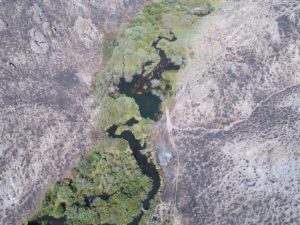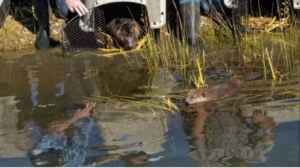Two wonderful beaver stories broke yesterday. One from Toronto and one from Dallas. We could probably wait for the rest of our lives and the next one before something like this ever happens again.
Houston’s bad beaver is California’s good beaver
You might recall my blog from November about the Idaho Fish and Game 1940s project to relocate bothersome beavers.
They parachuted beavers to a new home and that proved effective in more than one way–the nuisance from the beavers disappeared and the beavers did great work on a part of southwestern Idaho’s forests and rivers.
 In fact, today some eighty years later, the beavers’ home is lusher, greener, and more full of life than surrounding areas thanks to all that dam building and reforestation. Proof positive: in 2018 the Sharps Fire burned some 65,000 acres of that Idaho refuge and did NOT affect the beaver’s home of wetland complexes.
In fact, today some eighty years later, the beavers’ home is lusher, greener, and more full of life than surrounding areas thanks to all that dam building and reforestation. Proof positive: in 2018 the Sharps Fire burned some 65,000 acres of that Idaho refuge and did NOT affect the beaver’s home of wetland complexes.
Boy it’s true what they say. A picture really is worth 1000 words. That one has sure ;left a mark on society. Thank you Joe Wheaton.
Given all this in Idaho, I was delighted but not surprised to see an article where the California Department of Fish and Wildlife released a small group of beavers to their native habitat for the first time in 75 years!
Beaver populations were decimated by the fur trade a hundred years ago and, as we know, beavers can be brats when it comes to damaging trees and building dams where we don’t want them.
In fact, just this week, neighborhoods in Livingston were cut off due to high water because beavers had dammed up the culvert! When our heavy rains came, the drainage system had fallen victim to beavers doing what beavers do.
 Clearly, beaver shenanigans can be a pain in the fur. So this new attempt in California to co-exist with these rascally rodents is refreshing! Valeria Cook, who manages this beaver restoration program, says: many government agencies statewide are spending hundreds of thousands to millions of dollars a year just to mimic what beavers naturally do to restore the natural ecosystems they live in. The animals are capable of reconnecting streams to floodplains and can help recover near-extinct species like coho salmon by creating new wetland habitats and encouraging the growth of the plankton and insects they feed on. Beaver dams can also slow down water flow and improve water quality by preserving sediment and nutrients in streams.
Clearly, beaver shenanigans can be a pain in the fur. So this new attempt in California to co-exist with these rascally rodents is refreshing! Valeria Cook, who manages this beaver restoration program, says: many government agencies statewide are spending hundreds of thousands to millions of dollars a year just to mimic what beavers naturally do to restore the natural ecosystems they live in. The animals are capable of reconnecting streams to floodplains and can help recover near-extinct species like coho salmon by creating new wetland habitats and encouraging the growth of the plankton and insects they feed on. Beaver dams can also slow down water flow and improve water quality by preserving sediment and nutrients in streams.
Valeria? Really? Just to be clear. moving 7 beavers from Sutter to Plumas isn’t trying to “Coexist”. Coexisting is what Martinez did and what Napa and Fairfield doing. Unfortunately there aren’t big news cameras and photographers to document that.






































